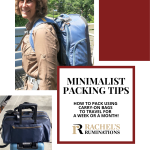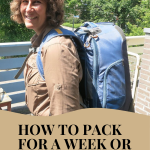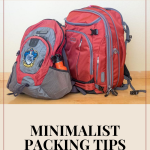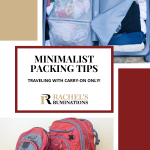Minimalist packing tips: How to travel light!
Do you want to save time in packing your luggage for a trip? Do you want to avoid long lines to get your baggage? Would you like to avoid lugging heavy bags from place to place? Or do you want to spare yourself the extra fees charged by the airlines or trains? Here are some minimalist packing tips to help you get ready before you head out on your next great travel adventure without your bags holding you back.
Note: This article is the result of a joint effort by Rachel and Exploration Junkie.
Disclosure: This article contains affiliate links. If you click on one and make a purchase, I will receive a small commission. This will not affect your price.
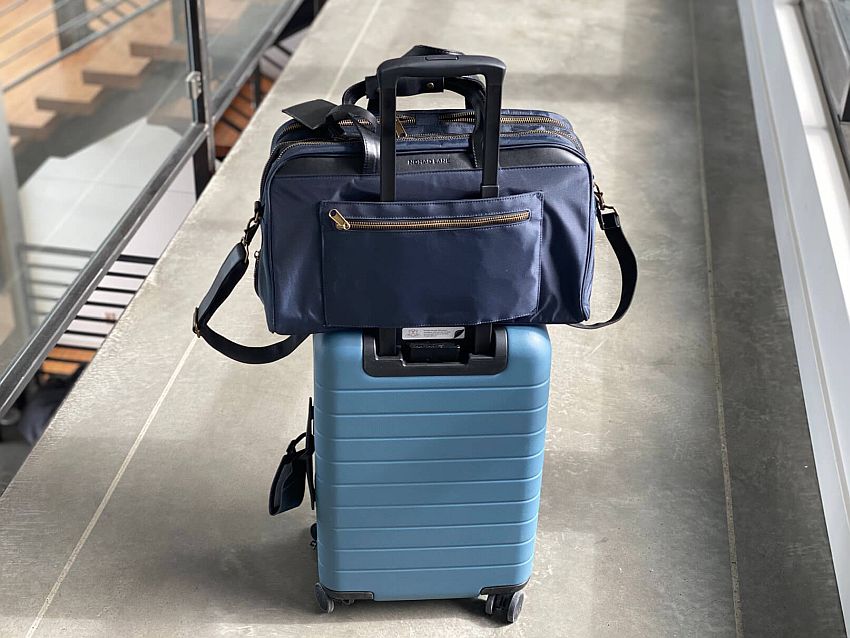
Packing things lightly is most ideal for independent travelers because you have a very limited capacity to bring all your belongings; you’ll need to move them from place to place yourself. Just to be clear, minimalist packing does not mean you have to leave necessities at home to save a lot of space in your luggage. Rather, it is picking out the necessary items efficiently, knowing what can be useful to you in most situations during your travel. It is also about saving time by avoiding repetitive packing and unpacking things.
Ideally, you can travel without checking any bags at all, just taking one bag that fits in an airline’s overhead bins and one smaller bag that fits under the seat in front of you. That should be enough even for months of travel!
Listed below are some minimalist packing ideas to help you get started:
What luggage should you choose?
To some extent luggage is a personal choice: some prefer duffel-style, some prefer a backpack, some would rather a wheeled bag, hard-sided or soft-sided. In any case, you should be able to pack everything into two bags, a so-called “carry-on bag” that fits in the overhead compartment of an airplane, and a smaller bag that fits under a seat.
Make sure to check every time you fly what the dimension and weight limits are for the airline you’re flying! At the moment the standard limit for carry-ons on US airlines is 22″ x 14″ x 9″ (55 cm x 35 cm x 25 cm), but these standards keep changing, and international carriers often have different limits. Most airlines set a weight limit as well, so check that too and stay within it to avoid unpleasant surprises at the airport. This chart lists the major airlines, but it’s a good idea to check directly with the airline in case they’ve changed it.
In choosing a carry-on bag, generally up to about a 35-liter capacity should be enough. More than that and you’ll likely not be able to carry it on. If you’re traveling by train or bus, the rules are usually more relaxed.
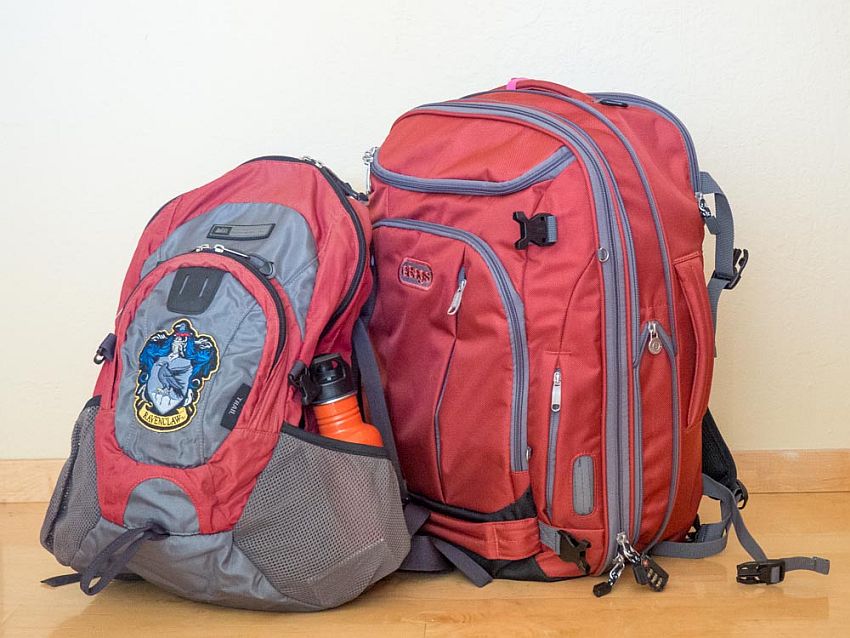
Pros and cons of each type of luggage
Wheeled luggage
Wheeled luggage is easy to walk with because you don’t have to carry it – but only if the surfaces are smooth and elevators are available instead of just stairs. Check online about whether you’re likely to have to carry your bag at your destination.
Wheeled luggage comes in hard-sided and soft-sided varieties. Hard-sided is good in that it limits what you can pack, i.e. it won’t expand to fit extra stuff (which might make it too big to use as a carry-on). It also is quite good at protecting what you carry. Often the space inside it is big: just one space on each half, which means something like packing cubes might be necessary to keep your things organized.
Soft-sided wheeled luggage comes with the temptation to fit “just one more sweater” in, but at the same time it’s also easier to fit the bag into tight spaces because it can be squeezed a bit. These bags are also more likely to have more separate pockets inside.
Backpacks
Backpacks are distinctly better if you plan to go off-road, i.e. hiking or anywhere where sidewalks or paved roads are scarce. Of course, the disadvantage is that you have to carry them, and that can be hard on your back – another reason to pack light! The most comfortable backpacks have both a chest strap and a hip strap, so some of the weight is carried on your hips rather than all on your shoulders. Backpacks, like soft-sided wheeled bags, also may tempt you to add more stuff just because you can fit it in.
Note: There are some brands such as Eagle Creek that make convertible backpacks. They have wheels, but also backpack straps. This covers all eventualities, though you may give up some space in the bag where the straps are stored. Some of these convertible bags only have shoulder straps in their backpack configuration, so make sure to choose one with hip straps if you’re likely to carry it any distance.
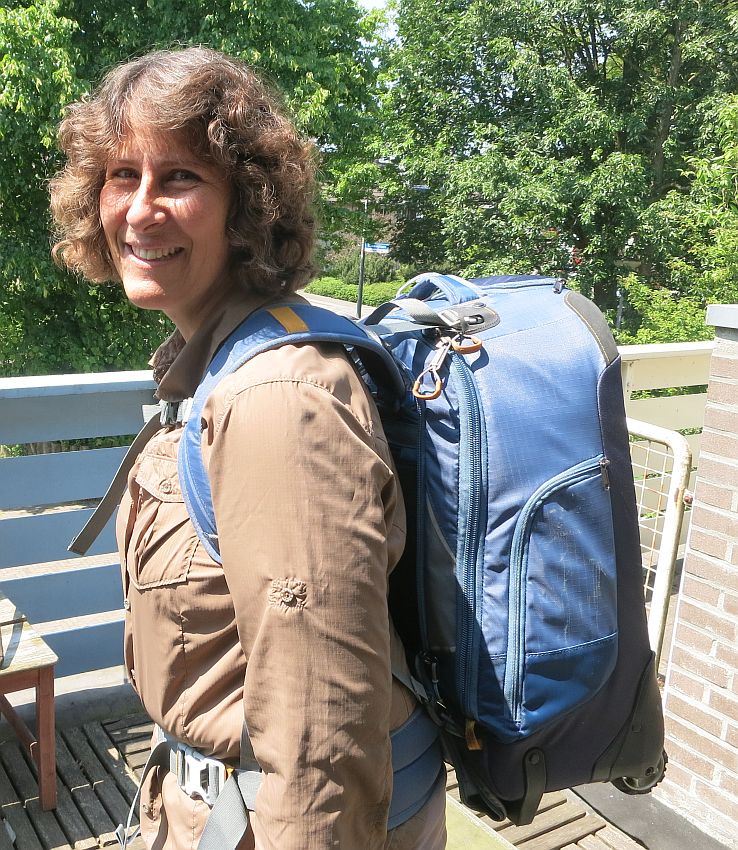
Duffels
Duffels are more free-form, in general, than the others, in that they often just have one big space with a couple small pockets inside or outside. Like with soft-sided wheeled bags and backpacks, you might tend to pack in too much. Duffels usually have two handles and one shoulder strap. For long distances, carrying a weight like this on one shoulder or hanging from one hand can become painful. Look for a duffel that you can carry as a backpack, or find a duffel with wheels.
Tip: Buy the highest quality bags you can afford. It’ll be worth it in the long run because you won’t end up going through a series of cheap bags that all fall apart quickly – which can really mess things up if it happens mid-trip! A good-quality bag should last upward of 20 years. Try PacSafe, for example, or Eagle Creek or Samsonite.
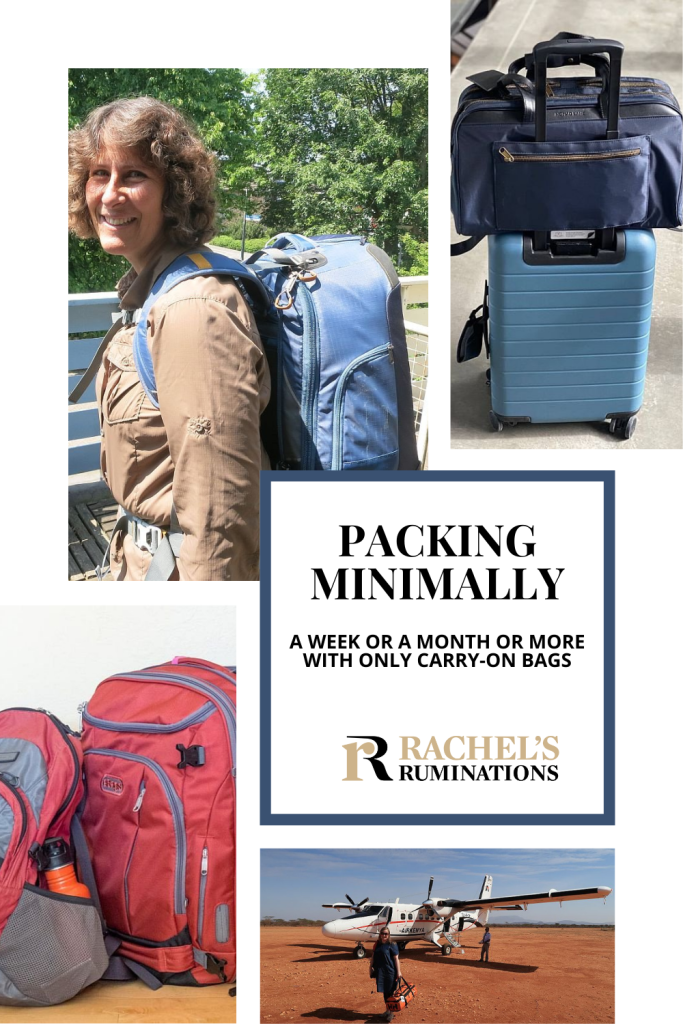
Start with a list
Creating a list will help you identify and evaluate the items that you will be needing for the trip. What bag will you use? What categories do these items fall into? Are toiletries available at the destination? Can you wash and reuse your clothes? Are these sets of clothes really essential?
This may take a lot of time, but it will help you in narrowing down the items to bring. It is a better alternative than looking around and just picking out items that you would regularly bring every time you go out, only to realize midway that some of the things you have packed are not even essentials. And you may just be overpacking.
When creating your list, it’s better to put it into writing or use a digital template on your preferred application. Doing this will help you cross out or add some items easily. After that, you can start packing! You can also reuse the list – with adjustments based on your experience – for future trips.
Read the rest of this article before starting your list!
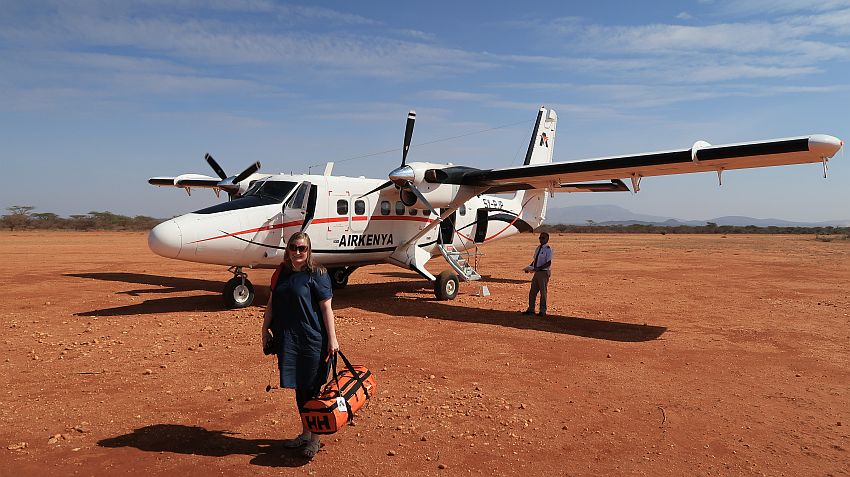
Look for carry-on duffel bags like Heather’s (in the photo above) at Luggage Online. For less rugged travel, there are even duffel bags with wheels!
Choose what clothing to bring
To save space, make a wardrobe capsule that allows you to mix and match outfits without affecting your comfort and sense of style. Stick with a single palette: for example, choose black, white and red clothing. Then you can mix and match depending on where you’re going that day.
Whether you plan on going on a day trip to Zaanse Schans from Amsterdam or visit Dunnottar Castle from Aberdeen in Scotland, try to pick out multipurpose clothes. And consider what you’ll wear if it rains – bring a light waterproof jacket? Or a small umbrella?
Plan to wash clothes
If you are going to travel for more than a week, plan to wash clothes about once a week.
If you stay in self-catering accommodations, try to book one with a washing machine. Otherwise, find a laundromat nearby. Alternatively, do your laundry by hand in your hotel sink.
Tip: Shampoo works fine as a hand laundry detergent!
Remember that you can wear clothes more than once. Depending on the weather and how much you’ve sweated, pants, shorts or skirts can go multiple days, and even shirts can often go more than one day, as long as they look clean and don’t smell! Since you’re traveling, the strangers you come in contact with won’t know you’re wearing your jeans for the third time! So this means that when you make your list of clothing to pack, plan on 7 pairs of underpants, but fewer of everything else.
Tip: Skirts with shirts are better than dresses. If you, for example, spill something down your shirt, you can still wear the skirt again. If you do the same thing with a dress, the whole dress is out of circulation until you can do laundry.
Know your footwear
You can figure out what shoes to bring by knowing their purpose and considering whether you will really use them. Since shoes are bulkier and heavier than your other items, they often take a lot of space in the bag. Remember, though, that you can wear one pair as you travel, so choose your heaviest or bulkiest shoes to wear on the plane or train.
When picking the shoes to bring, make sure they are well-matched with your outfits and suitable for what you plan to do, be it walking around a city like Singapore, touring a far-flung UNESCO site like Baalbek in Lebanon, or exploring one of the world’s most intriguing landscapes in Venezuela such as Mount Roraima. Your shoes must not limit your freedom to wander around.
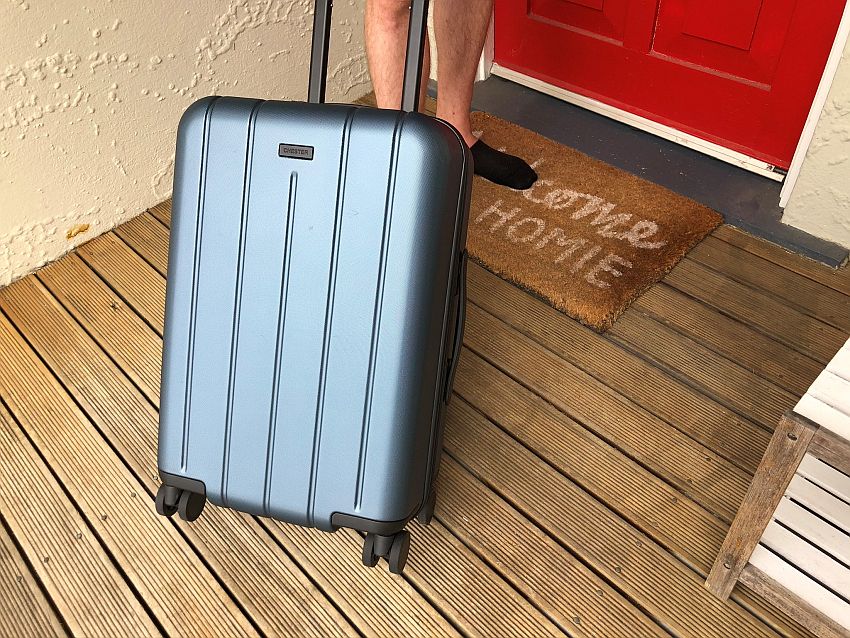
Order from a large selection of carry-on bags – the kind that go in the overhead compartment – at Irv’s Luggage or Luggage Online.
How many shoes?
Having said that, for most trips it’s enough to take just two pairs of shoes. If you’re going to a warm-weather place, wear walking shoes or sneakers on the plane and pack comfortable walking sandals. You can also fit in a pair of flip-flops easily or buy a pair at your destination.
For a cold-weather place, wear your biggest, warmest shoes on the flight: hiking shoes, for example. Then pack one more pair of warm shoes. That should be enough, unless you will be staying in a hostel, in which case you should also pack flip-flops to use in shared showers.
Tip: The disposable shower caps you get in hotels are perfect to cover the soles of your shoes so that when you pack them, they don’t get your clothes dirty!
Bring multipurpose items
Keep in mind that everything inside your bag should be only what you’ll be needing and using. Carry multipurpose items that are tailored to fit all of your travel destinations. One example would be a simple long-sleeved shirt or blouse. You can use it as a loose cover-up when you need to cover your shoulders visiting a cathedral or mosque, for example, but button it up and use it as your shirt in the evening when the temperature goes down, rather than packing an additional light sweater.
Take note that not only clothes can have multiple functions. There are also toiletries and cosmetic products you can use for varying purposes. For anywhere sunny or near the equator, consider bringing sunscreens with moisturizer, a two-in-one item that can help you stay protected from the sun’s UV rays while keeping your skin blemish-free and hydrated. EezySun sells small travel sizes of SPF50 combined with insect repellent or foundation makeup. Also, liquid soaps packed with essential oils can be used as a body wash, shampoo and laundry detergent. Better yet, bring a bar shampoo, so you don’t have to deal with liquids through security. One great benefit you can get from bringing multipurpose items is that you can easily squeeze them into the small pockets of your bag.
Be digital
We are in a golden age of technology where we can fit all of our valuables into a single item. With a phone, tablet, or laptop, you can take a lot of photos, access maps, make notes, store identification cards, keep plane tickets, and settle bills. Your digital device allows you to access all of that without stuffing everything inside your wallet or backpack pockets.
Decide what you will actually use. Unless you are planning to work while you travel, you can probably leave your laptop home. A smartphone will suffice for most other purposes.
Tip: Make sure you have a “find your phone” app set up and ready to use, just in case. Give access information to a friend or relative back home so they can use the app if you need help.
Another tip: Check your phone’s memory before you leave to make sure it has room for lots of pictures.
If your phone plan doesn’t cover your destination, make sure your phone is unlocked, or that you have a dual-sim phone. On arrival in most airports you can pick up a data sim card so you can use your phone anywhere on your trip. Another option is to buy an e-sim and install it, then just activate it on arrival. Make sure to pay ahead of time for the data plan you’ll need.
Don’t forget a charger! Some rental cars have chargers in them, and some higher-end hotels have built-in USB charging ports in their rooms, but many don’t. Bring a charger and a plug, and make sure to check which kind of outlet your destination uses. If it’s different, bring an adaptor along as well. These are readily available in airports and international train stations.
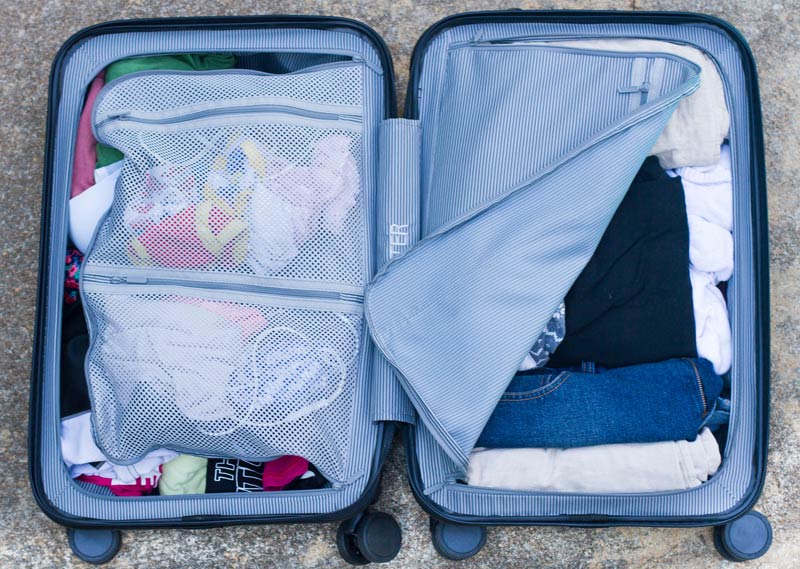
Necessities to bring
Of course, there are necessities that you have to bring.
Medications: both prescription and over-the-counter. Bring all meds in their original packages so it’s clear what they are. Some meds – things like cannabis-based items, narcotics or ADHD medications – may be on a controlled substance list. If so, the country might have requirements like a doctor’s signature on a form. Find the requirements by looking on an official government or embassy website of that country.
Passport and other documents: You won’t get far without your passport, but you may need other paperwork as well: a visa, for example. Check well beforehand.
Money: No one uses traveler’s checks anymore, so you’ll have a very hard time finding anyone who accepts them. Don’t bother with them. Instead, take at least one credit card – Visa and Mastercard are the most accepted ones – and a debit card as well, for ATM withdrawals.
Depending on the country you are visiting, you may never need any actual cash, especially in western Europe, where payments are often electronic, using a card or phone. In other countries, you might need to have ready cash. Even in Europe cash is useful for things like buying small items or tipping. The easiest way to start out is to take cash out of an ATM using your credit or debit card on arrival. Check ahead of time to see how much your bank will charge you for doing this. If it’s a lot, take out more on each ATM visit so you avoid paying that charge too many times.
Tip: Make sure your bank account and credit card are set up to allow you to withdraw money when you’re overseas.
What not to bring
Think carefully about what you really need to bring. For example, is that yoga mat really necessary? Could you instead do yoga on a towel on the beach?
Another example: make-up, hair gel, perfume, etc. You may feel that make-up is necessary at all times, but really it’s not! Keep in mind that, like with twice-worn clothes, the strangers you meet on the road don’t know what you normally look like. Who cares what they think of short eyelashes or pale lips? You can save a lot of space – and issues at security checks – by leaving all of those creams and potions at home! Just bring what is necessary for your physical well-being and hygiene: sun cream, for example, is necessary, as is antiperspirant (so you can re-wear your shirts!), basic soap and shampoo, toothbrush and toothpaste, and a comb or brush.
Another thing to leave home is any electrical appliances. A hair dryer or curler, besides being absolutely unnecessary – remember, they’re strangers! – needs to have the same current it was built for. So if you are going to bring one, you not only need an adaptor to fit the local outlets, you may also need a converter if you are, for example, traveling from the US (110 volts) to Europe (220 volts).The same goes for any other appliances besides laptops, smartphones or tablets, which are designed to accept both 110 and 220.
Minimalist packing tips for shopping
You might be concerned about not having enough room to bring back souvenirs. There are four ways you can approach this:
- You could wait till the last stop of your trip to do your shopping. Buy a cheap bag there that fits within the carry-on limits. Use it as your carry-on on the way home, checking the bag you used on the outward journey. This way you’ll have more luggage on your way home, and you’ll have to wait for your luggage at the baggage handling on arrival, but at least you won’t have to carry it all through all the stops of your trip.
- Another possibility is to make a strict rule for yourself only to buy very small gifts: jewelry works well, for example, or fridge magnets.
- Alternatively, if you’re flying home, you can wait till you’re at the airport to buy souvenirs. Most airlines allow you to take your airport purchases onboard as an extra in a duty-free shop bag.
- A fourth option is to mail your purchases home. Ask vendors to pack them well, then either have them do the shipping for you or, if that’s not possible, take the packed items to a post office to send yourself. It costs a bit more but it’s worth it to not have to struggle with your luggage.
Tip: If you are taking a long trip and notice that you’ve packed things you aren’t using, you could send them home too, or give them away if they’re not important to you.
Now, get packing: More minimalist packing tips!
Get started several days before your trip so you have time to consider what is really necessary and to pack and repack until you get it right.
There are different schools of thought on how to pack efficiently:
- Many just fold everything neatly right into the bag.
- Some use compression packing cubes, which squeeze the clothing more than just folding. This allows more to fit, but that can also be a downside, leading you to pack more than you need – airlines often have weight limits on carry-on bags too. On the other hand, they allow you to stay organized with, for example, one cube for pants, one for shirts, etc.
- Some prefer to roll their clothes, either into packing cubes or directly into the bag. When rolling clothes to pack into the bag directly, they can be packed vertically, which allows you to find individual items easily.
If you pack everything into your one carry-on bag and your one under-seat bag, and you have to push hard to get the bags closed, you’ve packed too much! Take it all out and see what you can leave behind!
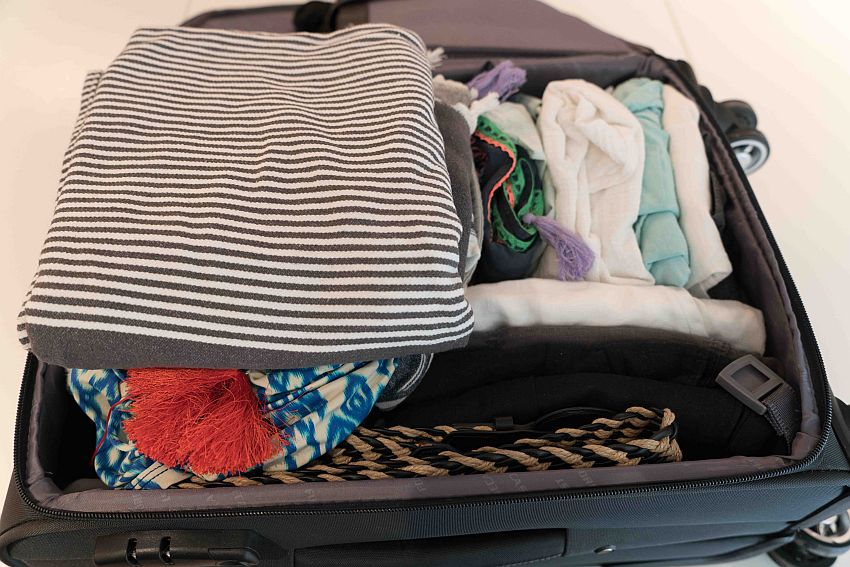
Minimalist travel packing list
Now that you know what to bring and what not to bring, you should be able to make your minimalist travel packing list.
We’ve heard of travelers who go extremely minimalist with packing. They pack just three outfits: one to wear, one to wash, and one extra for if the washed clothing is still wet. They wash one outfit every evening in their accommodations. The disadvantage of this, of course, is having to wash clothing every single night consistently.
Assuming you don’t want to be that extreme, here’s a generic version of our packing list, but you’ll have to make your own depending on where you are traveling to and what the weather is expected to be like. This should be sufficient whether you’re traveling for a week or for several months:
Clothing
- 6-7 underwear (+1-2 bras)
- 3-4 bottoms (i.e. shorts, long pants, capri pants, leggings or skirts)
- 5-6 tops (i.e. short or long-sleeved shirts or blouses, or a mix)
- 1 pajama (or just wear one of the tops or nothing at all!)
- 1 outerwear, depending on the destination (a sweater, sweatshirt or light jacket – but wear the heaviest jacket on the plane, train or bus to your destination)
- 1 pair of walking shoes or sandals
- 1 pair flip-flops (optional)
- Socks (6-7 pairs if you expect to wear them every day; otherwise, just 2-3 pairs)
- A sun hat if you’re going to be spending time outside in the sun
- A swimsuit, if needed
- A thin raincoat, if necessary, that you can layer.
Other things
- Passport and other documents
- Credit cards, money, etc.
- Medications
- Toiletries including toothbrush, toothpaste, deodorant, hairbrush or comb, shampoo, etc. (Remember that any liquids have to be packed in a separate plastic bag to go through security and be in small quantities: maximum 3.4 ounces or 100 milliliters)
- Smartphone and other optional electronics (modem, tablet, kindle, etc.)
- Headphones (optional)
- Charger(s)
- Adaptor(s)
- A camera and a means to charge it (optional because you can just use your smartphone)
- Any more specialized items for your particular trip, e.g. walking sticks, snorkel gear or binoculars.
Wear for travel
- 1 underwear
- 1 long pants or skirt
- 1 top – your biggest one
- 1 jacket (your heaviest outerwear, preferably waterproof so it can double as rainwear. If you’re going somewhere cold, wear your heaviest jacket and your heaviest sweater.)
- 1 pair of socks
- 1 pair of shoes: your heaviest or bulkiest pair
Your underseat bag
Most of what we’ve listed above will go in the larger carry-on bag that you’ll place in the overhead compartment. The bag under your seat is where you should pack the following:
- Whatever you’ll need during your flight or train trip: gum, snacks, headphones, passport, wallet, a water bottle (empty through security, refilled before boarding), kindle, smartphone, etc.
- Whatever you want to keep close to you so it won’t get stolen or lost: cash, electronics, medications, etc.
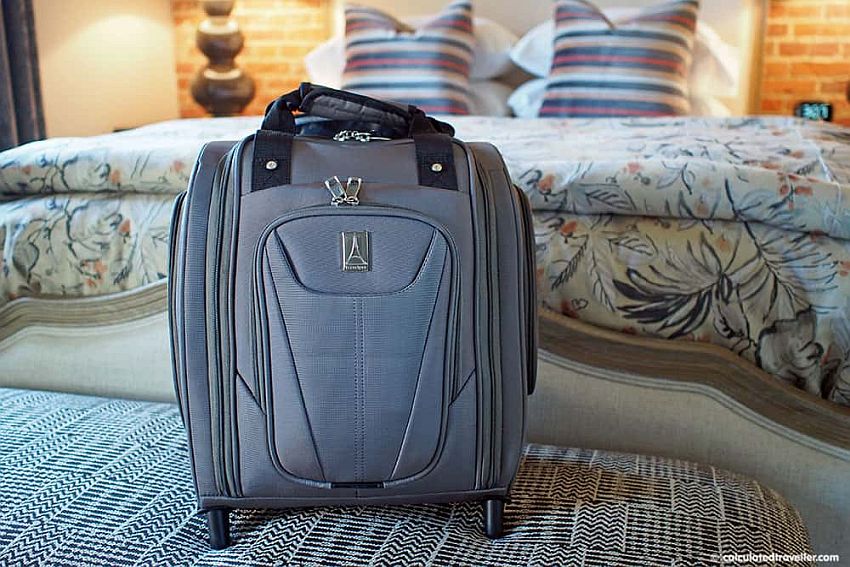
With all the minimalist packing tips discussed above, remember that the key to minimalist packing is reducing the bulk in your luggage and efficiently packing your items, which can save you both time and money. To do so, be creative in making your travel essentials as flexible as your travel goals.
We’d love to hear about how you pack as well as any additional tips about packing light! Add your comment below!
My travel recommendations
Planning travel
- Skyscanner is where I always start my flight searches.
- Booking.com is the company I use most for finding accommodations. If you prefer, Expedia offers more or less the same.
- Discover Cars offers an easy way to compare prices from all of the major car-rental companies in one place.
- Use Viator or GetYourGuide to find walking tours, day tours, airport pickups, city cards, tickets and whatever else you need at your destination.
- Bookmundi is great when you’re looking for a longer tour of a few days to a few weeks, private or with a group, pretty much anywhere in the world. Lots of different tour companies list their tours here, so you can comparison shop.
- GetTransfer is the place to book your airport-to-hotel transfers (and vice-versa). It’s so reassuring to have this all set up and paid for ahead of time, rather than having to make decisions after a long, tiring flight!
- Buy a GoCity Pass when you’re planning to do a lot of sightseeing on a city trip. It can save you a lot on admissions to museums and other attractions in big cities like New York and Amsterdam.
- Ferryhopper is a convenient way to book ferries ahead of time. They cover ferry bookings in 33 different countries at last count.
Other travel-related items
- It’s really awkward to have to rely on WIFI when you travel overseas. I’ve tried several e-sim cards, and GigSky’s e-sim was the one that was easiest to activate and use. You buy it through their app and activate it when you need it. Use the code RACHEL10 to get a 10% discount!
- Another option I just recently tried for the first time is a portable wifi modem by WifiCandy. It supports up to 8 devices and you just carry it along in your pocket or bag! If you’re traveling with a family or group, it might end up cheaper to use than an e-sim. Use the code RACHELSRUMINATIONS for a 10% discount.
- I’m a fan of SCOTTeVEST’s jackets and vests because when I wear one, I don’t have to carry a handbag. I feel like all my stuff is safer when I travel because it’s in inside pockets close to my body.
- I use ExpressVPN on my phone and laptop when I travel. It keeps me safe from hackers when I use public or hotel wifi.


